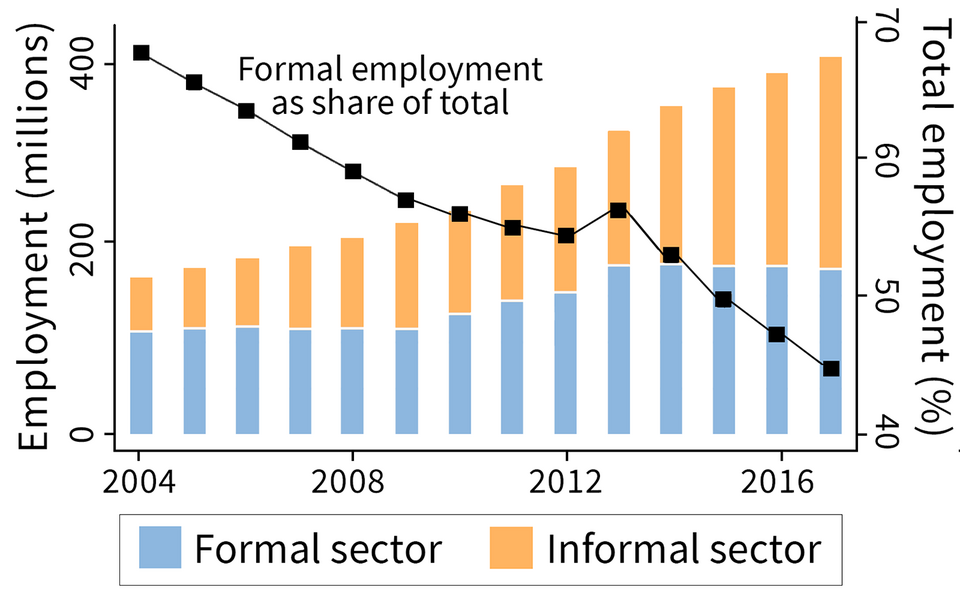Invisible China: Hundreds of Millions of Rural Underemployed May Slow China’s Growth
Invisible China: Hundreds of Millions of Rural Underemployed May Slow China’s Growth [ 4 min read ]
Insights
- Approximately 500 million people in China, or 70% of the labor force, do not have a high school education.
- By this metric, China is the least educated middle-income economy in the world.
- Rising informality in the workforce, due in part to low levels of education and health outcomes in this group, may derail China’s transition to a high-skill, high-wage economy.
Source Publication: Scott Rozelle and Natalie Hell (2020). Invisible China: How the Urban-Rural Divide Threatens China's Rise. University of Chicago Press.
Moving from middle to high income—or not. According to World Bank data, only a handful of economies have risen from middle to high income since 1960. Examples include South Korea, Singapore, Israel, and Ireland. Some countries that were high income in 1960 are still high income today, such as Denmark and Japan. Others, like Myanmar and North Korea, have remained poor.
Yet, many countries have stayed at middle-income status for decades, seemingly unable to reach high-income status. Little is known about how China compares to these other countries stuck at middle income.

Education and the middle-income trap. One key factor that may account for the disparate development paths of countries is education. The share of workers with a high school degree in countries that graduated to high income was 72% when they were still middle income. Conversely, in countries that have failed to exit middle-income status, the share is much lower—36% on average.
Having a large supply of educated workers ensures that enough talent exists to meet and drive demand for higher-value services, thereby sustaining growth. When too many unskilled workers are squeezed out of upgraded industries, their wages can stagnate, curtailing demand and hampering growth—and eventually leading to serious social problems, such as more crime, higher rates of unemployment, and social unrest.
How does China measure up? The share of uneducated workers in China’s labor force is larger than that of virtually all middle-income countries. According to census data, there are roughly 500 million people in China between the ages of 18 and 65 without a high school degree.
A large population of uneducated workers was not a problem when China moved from low to middle income. Unskilled wages were low and there was growth in low-cost manufacturing and construction. But China’s growth model is changing as it gets wealthier. Unskilled wages are much higher, but the lure of cheaper labor elsewhere and China’s massive push to automate is rendering low-skilled workers redundant. Construction jobs have tapered off as investment in infrastructure cools. These factors suggest China’s unskilled workers may be increasingly unemployable as the economy upgrades.

Rise of informal sector. The only destination for China’s unskilled workforce—whether new entrants or laid-off workers—is the informal service sector. Informal employment is currently the fastest-growing sector in China, increasing from 33% in 2004 to 56% in 2017. The rising supply of workers has ushered in stagnating wages for unskilled workers. Meanwhile, strong demand for skilled work means higher wages for those with an education. The result may come to resemble Mexico: a case of solid macroeconomic performance, export success, and accumulation of physical capital, yet little growth in the formal economy.
Are China’s investments in education too little, too late? Recognizing the need for secondary education, China’s government has expanded access to high school throughout the country. High school attainment among the youngest cohorts in the labor force is close to 80%. But hundreds of millions of less educated people will remain in the labor force for the next 30 years. The government will face huge challenges trying to either re-train workers or provide a social safety net.
The quality of China’s expanded secondary school education is also uncertain. Almost all unskilled labor comes from rural areas where the school and health systems are under-resourced. Many of the new secondary school graduates attended poor-quality vocational schools. Systemic shortfalls in early childhood education and health in rural areas may also render many young people unprepared to learn complex skills as they age.
A global problem. The risks of a stagnating China would reverberate far beyond its shores. Its sheer size—one-fifth of the world population—means that what happens there will have outsized implications for foreign trade, global supply chains, financial markets, and growth around the globe. There are political perils too. An economically insecure China may turn to nationalism to boost legitimacy. In the end, no assessment of China’s growth is complete without considering the implications of having hundreds of millions of underemployed people in China’s economy for the foreseeable future.
